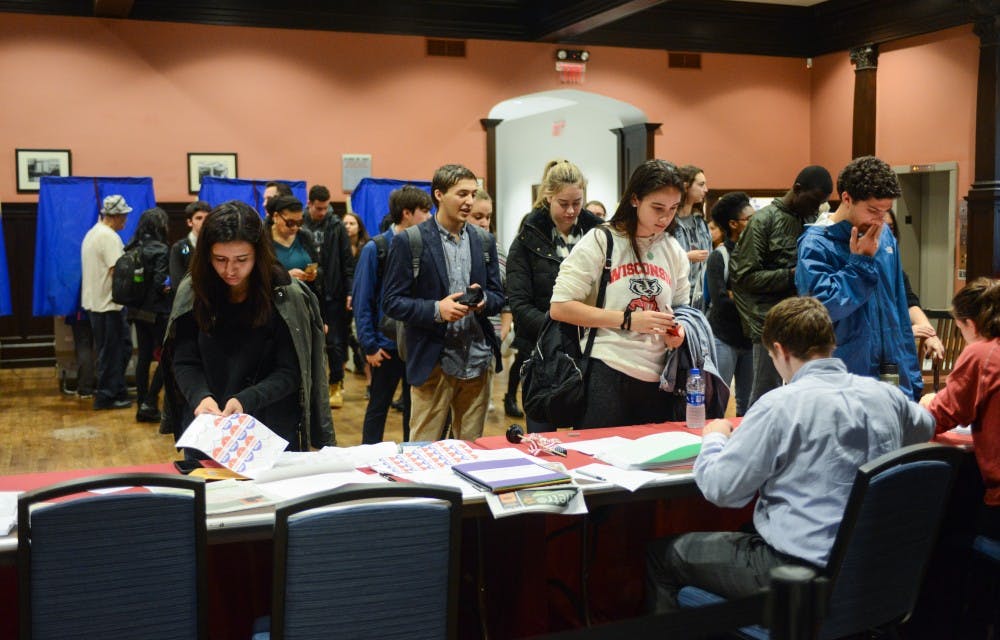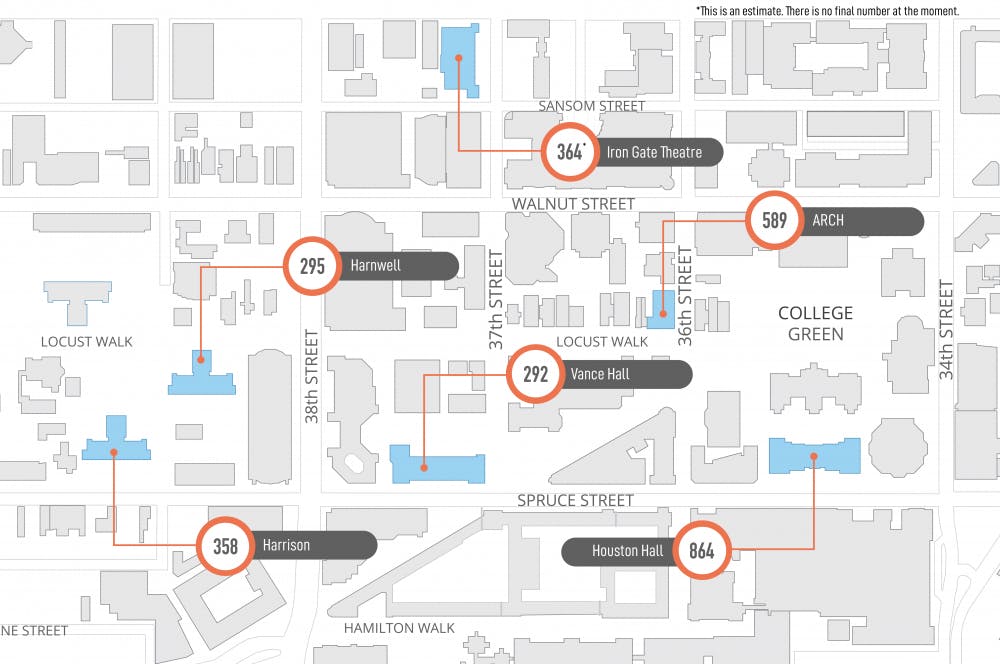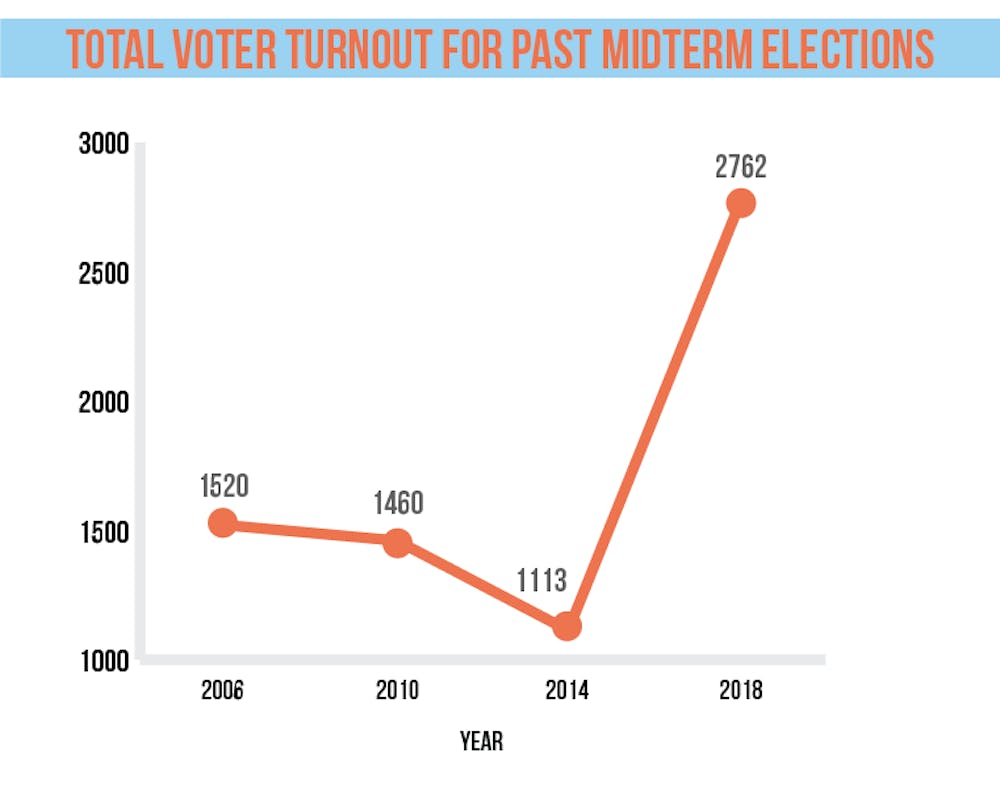
The voter turnout on the University of Pennsylvania's campus for the Nov. 6 elections was higher than that of any midterm election in the past 12 years, with numbers comparable to those from the 2016 presidential election.
According to election judges stationed at the six on-campus polls, a total of 2,762 ballots were cast on Penn's campus. This is more than double the 1,113 voters who turned out to the 2014 midterms.
Penn is not alone — voter turnouts are up at polls across the country. Early Nov. 7, Nate Cohn of The New York Times estimated that there were around 114 million votes casted in the House of Representatives, significantly exceeding the 83 million voters that participated in 2014.
Houston Hall was the most popular voting location on campus, with 864 votes reported. The ARCH building on Locust Walk came in second with 589 ballots casted, followed by Harrison College House with 358. Vance Hall, along Spruce Street, reported 292 voters, one of which was Penn President Amy Gutmann.
There were no final numbers at Iron Gate Theatre as polls closed at 8 p.m. on Nov. 6, and election officials said this was a result of voters submitting incomplete ballots.

The last time students voted on campus in a general election was the 2016 presidential election, which propelled 1968 Wharton graduate Donald Trump to the White House. During that fateful Tuesday night two years ago, 1,037 voted at Houston Hall, 620 at Arch, 518 at Vance Hall, 433 at Harnwell, and 356 at Harrison.
Looking at midterm election polling results over the years at Penn, 2018 is a clear outlier in its high turnout. Back in 2006, just 1,520 voters casted ballots, followed by 1,460 in 2010, and a low of 1,113 in 2014.

ARCH election judge, 1998 Penn doctorate, and 2008 Liberal and Professional Studies graduate Daniel Flaumenhaft has volunteered at elections on campus for over 10 years, and said on Nov. 6 that this was the highest non-presidential turnout he's ever seen.
"It's not just way, way higher than is normal for a non-presidential year. This would be really good for a presidential year," Flaumenhaft said. "It's obvious that this is an election people are excited about and really care about."

Incumbent Gov. Tom Wolf (D-Pa.) easily won re-election over Republican challenger Scott Wagner, boosted by a similar margin of victory as incumbent Sen. Bob Casey (D-Pa.). Wolf won 177 to 9 in Vance, 266 to 24 in Harnwell, and 325 to 26 in Harrison.
Casey romped to a lopsided victory against opponent Rep. Lou Barletta (R-Pa.). In Vance Hall, Casey received 275 votes to Barletta's 15. In Harnwell, Casey received 269 and Barletta received 22. In Harrison, Casey received 325, and Barletta received 26.
In the last contested race, between Rep. Evans (D-Pa.) and Republican Bryan Leib for the 3rd District seat, Democrats also emerged victorious by wide margins. Evans took 274 to 15 in Vance, 269 to 24 in Harnwell, and 322 to 33 in Harrison.
Penn College Republicans interim President and College senior Richard Murphy, who watched the election from the group's watch party at Smokey Joe's bar said that throughout the night, he gradually came to terms with the Democratic overturn of the House.
“Coming from a Penn perspective, seeing what I am seeing, there is a lot of anger from the left, and anger does drive votes,” Murphy said. “It looks like the blue wave is real.”
The increased turnout this year was also clear when comparing the gubernatorial races of the 2014 midterm to the 2018 midterm, according to numbers provided by the Philadelphia City Commissioner to Penn Democrats President and Wharton junior Dylan Milligan.

In the race on Nov. 6, 1,888 more votes were cast overall. Harrison had 228 more votes, Harnwell had 201 more votes, Vance had 130 more votes, Houston had 614 more votes, Arch had 459 more votes, and the location for Iron Gate Theatre's precinct had 256 more votes.
Penn's increased turnout comes after weeks of activism from student groups such as Penn Leads the Vote, a non-partisan group that aims to boost the University's low voting rates. The group hosted an Election Day celebration on the Harnwell Rooftop Lounge for the last three hours of open polls, attracting hundreds of students, as well as President Gutmann and Provost Wendell Pritchett.
Political Science professor Daniel Hopkins noted that the sizable wins of incumbents Casey and Wolf in Pennsylvania were particularly notable given the Republican victories in 2016.
Penn Writer in Residence and national political columnist at WHYY News Dick Polman also said the state made "a strong contribution" to the diversity in the new Congress by sending four Democratic women to the House of Representatives.
Staff reporters Avni Kataria and James Meadows and contributing reporters Ashley Ahn and Olivia Cheng contributed reporting.
The Daily Pennsylvanian is an independent, student-run newspaper. Please consider making a donation to support the coverage that shapes the University. Your generosity ensures a future of strong journalism at Penn.
Donate







